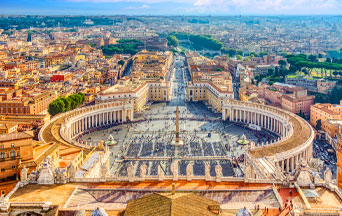
Pope Francis has convoked a Synod on Synodality, which will convene in Rome this coming October. Many concerned Catholics have been left wondering what synodality is and where it will lead the Church.
The following article from the recently published book The Synodal Process Is a Pandora’s Box strives to answer this key question.
On April 24, 2021, Pope Francis officially announced the program for this year’s Synod on Synodality in an address to the faithful of Rome.
He chose the theme: “For a Synodal Church: Communion, Participation, and Mission.” According to the pope, it is a matter of “Journeying together—laity, pastors, the bishop of Rome.”1 The greatest difficulty to overcome “is the clericalism that detaches priests and bishops from people” because “there is a certain resistance to moving beyond the image of a Church rigidly divided into leaders and followers, those who teach and those who are taught; we forget that God likes to overturn things: as Mary said, ‘he has thrown down the rulers from their thrones but lifted up the lowly’ (Luke 1:52). Journeying together tends to be more horizontal than vertical.”2
Get the book now! The Synodal Process Is a Pandora’s Box is now available for $10.95.
Click here to get your copy now.
The next Synod, therefore, will not discuss a specific pastoral theme, as is usually the case in these assemblies, but the very structure of the Church. For this reason, it is also known as the Synod on Synodality.
Defining Synodality
According to the International Theological Commission, the noun synodality was coined recently and constituted “novel language” not appearing in the Second Vatican Council documents or the Code of Canon Law. In the context of a new model of the Church, according to the Commission, “synodality is the specific modus vivendi et operandi of the Church, the People of God, which reveals and gives substance to her being as communion when all her members journey together, gather in assembly and take an active part in her evangelizing mission.”3
According to Pope Francis, “Synodality is an expression of the Church’s nature, her form, style and mission.”4 And thus, synodality is “a constitutive element of the Church.”5
Synodality Seeks Greater Lay Participation
Synod promoters claim that it would be proper for synodality to increase the participation and co-responsibility of all the faithful in the life of the Church. As the Vademecum for the Synod on Synodality prepared by the Synod Secretariat states, “The path of synodality seeks to make pastoral decisions that reflect the will of God as closely as possible, grounding them in the living voice of the People of God…In articulating the voice of the People of God expressing the reality of the faith on the basis of lived experience.”6 “Synodality calls upon pastors to listen attentively to the flock entrusted to their care.”7
Synodality’s Effect on the Life of the Church?
This listening to the whole community implies reformulating authority in the Church. According to Pope Francis, one must invert the Church’s pyramidal structure: “In this Church, as in an inverted pyramid, the top is located beneath the base.”8
Get the book now! The Synodal Process Is a Pandora’s Box is now available for $10.95.
Click here to get your copy now.
According to Cardinal Mario Grech, secretary-general of the Synod of Bishops, Pope Francis
“has provided a lively and inspiring model of the image of the “inverted pyramid” of the hierarchical authority…As Amanda C. Osheim rightly observes: “conceiving of hierarchical authority as an inverted pyramid reverses an older pyramidal conception of the church, a trickle-down ecclesial economy in which the Holy Spirit was given first to the pope and bishops, then to clergy and religious, and finally to the faithful…This pyramid effectively divided the Church into the teaching Church (ecclesia docens) and the learning Church (ecclesia discens). By inverting the pyramid, Francis’s analogy recasts authority as being dependent upon reception—listening to and learning from others—within the church.”9
Such a democratic reformulation of authority in the Church would make it possible to “overcome the scourge of clericalism” since, supposedly, “we are all interdependent on one another, and we all share an equal dignity amidst the holy People of God.”10
However, it is evident that the real scourge comes in the form of synodality, which looks to destroy the hierarchical structure of the Church established by Our Lord two thousand years ago.
Photo Credit: © Nikolay N. Antonov – stock.adobe.com
Footnotes
- Pope Francis, “Speech Commemorating the 50th Anniversary of the Institution of the Synod of Bishops” (Oct. 17, 2015), Vatican.va, https://www.vatican.va/content/francesco/en/speeches/2015/october/documents/papa-francesco_20151017_50-anniversario-sinodo.html.
- Pope Francis, “Address to the Faithful of the Diocese of Rome” (Sept. 18, 2021), Vatican.va, https://www.vatican.va/content/francesco/en/speeches/2021/september/documents/20210918-fedeli-diocesiroma.html.
- International Theological Commission, Synodality in the Life, no. 6.
- Pope Francis, “Address to the Faithful.”
- Pope Francis, “Speech Commemorating.”
- Synod of Bishops, Vademecum for the Synod on Synodality, 10—11, Synod.va, accessed Jun. 9, 2023, https://www.synod.va/content/dam/synod/common/vademecum/en_vade.pdf.
- Synod of Bishops, Vademecum, no. 2.3, 19.
- Pope Francis, “Speech Commemorating.”
- Cardinal Mario Grech, “Address of Cardinal Mario Grech to the Bishops of Ireland on Synodality,” CatholicBishops.ie., Mar. 4, 2021, https://www.catholicbishops.ie/2021/03/04/address-of-cardinal-mario-grech-to-the-bishops-of-ireland-on-synodality-2/.
- Synod of Bishops, Vademecum, 19.

